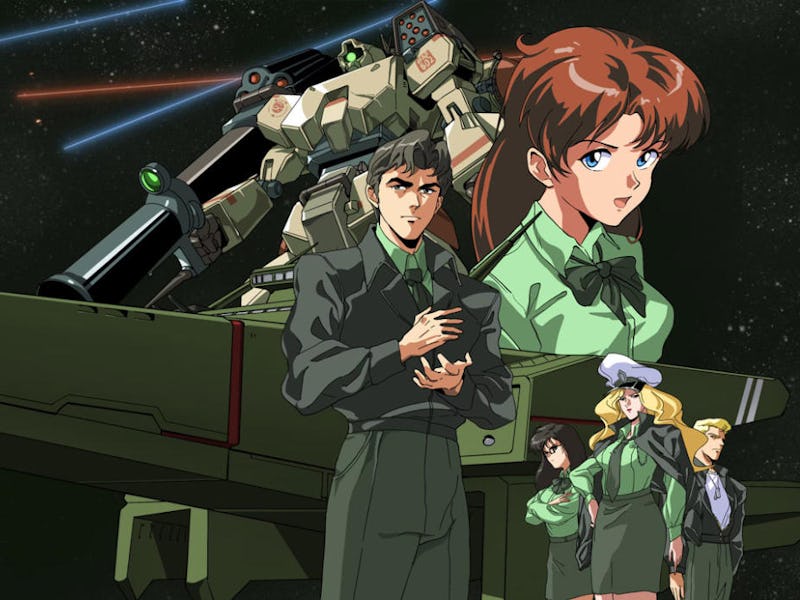Stories from Sol: The Gun-Dog Blends A Laid-Back Story With Anime Mech Battles
Big robots, small stakes.

It begins with a mech battle in space, the decisive confrontation in a struggle between Earth and an alliance of colonies on Mars and around Jupiter. Between that and Stories from Sol: The Gun-Dog’s sort of aggressive name, it might sound something like Armored Core. But in practice, it actually feels closer to some forgotten light-hearted mecha anime from the ‘80s, telling a character-focused story of intrigue in the midst of interplanetary conflict.
As much as The Gun-Dog is going for a retro anime feel with its story, it goes even further with its aesthetics. The game is modeled on visual novels for the PC-98, an old-school Japanese PC, which were known for their gorgeous pixel art. Not to say that it’s prioritizing style over substance, but one of The Gun-Dog’s biggest draws is the art.
The Gun-Dog’s gorgeous pixel art keeps its claustrophobic setting from feeling too dull.
Most of the game takes place on the titular spaceship the Gun-Dog, a patrol vessel intentionally kept small and lightly crewed for the sake of speed. Despite the story revolving around just a handful of characters in a dozen or so rooms, neither the cast nor the setting get old, partly because of just how good everything looks. For most of the game, animation is minimal but effective, consisting of a few character poses or blinking lights on monitors. Occasional fully animated sequences highlight scenes with more action, and they’re uniformly great. It’s all convincingly retro, without ever feeling like The Gun-Dog is sacrificing quality for the sake of nostalgia.
The Gun-Dog’s gameplay, too, has an old-school feel. The game is a linear visual novel with some dialogue choices to make, but little in the way of interactivity or branching paths. When the situation calls for more than clicking through dialogue, The Gun-Dog uses an old-school standard with a list of your actions on the right screen of the screen (things like “move,” “look,” “talk,” and “use”), that you need to select, then choose which object in the scene you’re interacting with. Puzzles strike a nice balance between paying attention to clues you’ve picked up through conversation and using a little common sense, rather than demanding too much brain power or asking you to brute-force your way through by checking every item in your inventory on each challenge you face.
An old-school interface complements the vibe of The Gun-Dog.
The Gun-Dog consciously evokes sci-fi shows from Mobile Suit Gundam to Star Trek. Its mechs are boxy and awkward-looking, and the ship itself is smooth and industrial, evoking a utilitarian sci-fi aesthetic. But rather than going for the high-stakes drama found in those inspirations, The Gun-Dog’s story stays fixed mostly on a smaller scale. To follow the Star Trek analogy further, it’s an episode where the crew has to work together to solve some technical problem plaguing the ship, not one where they do battle with the Borg.
The game opens with your character (whose name and gender you choose), in the cockpit of their mech, hanging from the side of a ship. Your squadron is heading into battle at the very end of hostilities with Earth, and a mechanical malfunction leaves you stranded, unable to help as many of them are picked off by the enemy. From there, time skips forward four years. You’re arriving aboard the Gun-Dog for duty, an assignment you quickly learn is due to your girlfriend Cassie, one of the ship’s officers, tampering with your records. The only other person aboard the ship you know is a crewmate from the game’s doomed opening excursion, who’s decidedly less happy to see you than Cassie.
The Gun-Dog mostly focuses on relationships between its ship’s crew, despite the interplanetary stakes.
The Gun-Dog takes its time setting up the rest of the crew, from the intimidating engineering chief and her dopey assistant to the unorthodox Captain Bartermews. It’s a cast of largely stock characters, but their interpersonal drama is still enough to carry an engaging plot that relies just as much on their big personalities as it does a surprise attack that leaves the ship compromised. While its laid-back approach to conflict makes playing The Gun-Dog as relaxing as tuning into a favorite corny sci-fi show, it can feel a little too low-key at times, lingering on long descriptions of technical tasks and letting every tension resolve a little too cleanly.
The Gun-Dog isn’t going to blow your mind, but it’s not really trying to. It’s a style exercise as much as anything, capturing the feeling of a long-ago age of visual novels in everything from its mechanics to its delightful lo-fi chiptune soundtrack. It’s also an attempt to establish a series, with further Stories from Sol games planned, making the comparisons to episodic space shows even more apt. The Gun-Dog is sci-fi comfort food, essentially, and I’ll be happy to come back for seconds.